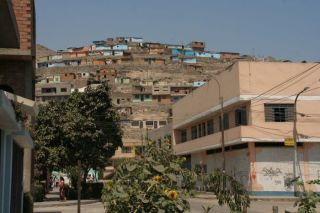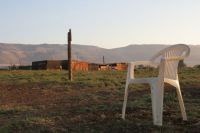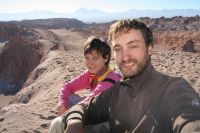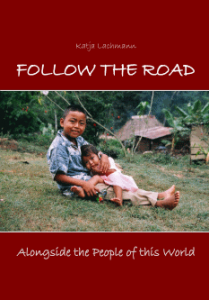The Desert – What a surprise!
May 28, 2008
Topics: Chile
Originally written for CoolWorks.com
For backpackers travelling without popular travel guides (e.g. “Lonely Planet”) or people like us, who usually do not know more than the currency rate of the country we are crossing the border of, the South of Peru and North of Chile can be quite a surprise.
After hitch-hiking a plane out of the Peruvian jungle (from Iquitos to Lima, the capital of Peru), we ended up staying with our friend Carla in the Comas district of Lima. A step out of the house and we had a great view onto two sandy hills without any vegetation. The only change in landscape was due to people’s houses living on the hills. Carla’s house was maintained mainly by her mom and brother who had to clean the dust each second day. If they would not wet the sandy street in front of their house each day, the desert would be in their house soon. We were astonished to see a completely shiny bathroom get covered in dust within only three days. At that time we thought it is only because of the hills which accidently happened to be in Comas. We did not realize that there the desert actually begun.
Moving on towards the South of Peru we noticed that all along the coastal highway was only sand and hills without any vegetation. Everything seemed drier than anything we had seen before. The only light were fields prepared for agriculture, which were showing how much this dry dusty sand can change into fertile ground once it gets watered.
Staying in Tacna (southern most Peruvian town) showed us more clearly the extremes of temperatures a desert has. During the day we enjoyed modest temperatures, not too hot, not too cold, simply pleasant. The nights got terribly cold though. Also this was not the worst so far since we stayed inside a house, slept inside a bed, and enjoyed all amenities of being “adopted” by a local family. Once it came to the shower, we did try to avoid it since night temperatures got close to zero degrees and ice-cold water showers were its result.
Heading to the Chilean border we still did not get aware of what may be ahead of us. We imagined Chile green and mountaineous. How wrong we were we understood during our first ride in a Chilean truck. We drove along vast areas which were nothing more nor less than pure desert. The Chilean desert is far from the Saharan like picture. It consists of mountains and hills covered by stones, sand, and salt. Sometimes a green valley appears (an oasis), where surprisingly many people live.
We also got a chance to stay for a couple of days in Lluta valley (Valle de la Lluta), about 10km North-East from Arica, which is close to the Peruvian border. Since my geographic lessons at school, I was dreaming to get to an oasis, and now I was staying right there. An amazing feeling. You leave the main road and you enter a green spot which never would let you guess you ended up in the desert. Water flowing in rivers, birds chasing each other through bushes and fields, greens instead of dust on our shoes. Life everywhere.
With few hazzles we arrived to Iquique, where the whole picture of the desert gets the biggest and most ridiculous contrast a desert can have: the sea. How can a desert exist if it has the sea right aside? Difficult to understand, especially when living right on the sea, being “guarded” by two huge mountains of sand in the back of our friends house.
We continued our trip through Chile by visiting Pica. Wind seems absent in this 95°F (35°C) degree hot oasis, and nights are way more warmer than we were used to. Pica’s plus: a tranquil tiny town with several thermal baths reachable by foot. A little paradise if it only was not so terribly hot during the day.
The driest desert of the world – the Atacama desert – was our next stop. Our destination – San Pedro de Atacama. The road seems endless. The time waiting in the heat for a ride equals ages. We succeeded though, after spending a night in a service station on the crossroad towards Calama. Water is precious and expensive here, but through a warm-hearted lady in the service station we managed to get sufficient drinking water for free. Her boss should not know, though.
San Pedro – a famous tourist destination in the Atacama desert. The main reason coming here was a chance to earn a bit for our living on the road by programing a website (Augustas speciality) for one agency selling horse rides. Stephanie, a Swiss girl dedicating her momentary life to work with horses leading tourists along unforgettable desert trails, cared for us in every possible way. Through her we enjoyed San Pedro, survived 23°F (-5°C) or less degree cold nights in our tent, got hot showers, a place to work, rest, eat, and even a horse ride. With her we found a great friend. Thank you, Stephanie!
San Pedro and the Atacama desert seemed to be the most extreme places we have experienced so far in the desert. The days are hot. Sun burns skin immediately, if not having a 60+ suncreme at hand. Lips break like paper, hands turn old, dry, ugly. Eyes get hurt without sun glasses. Nights are freezing cold. 23°F (-5°C) or less degrees are not inviting to camp, but we had no other choice.
Though it is beautiful. Walking at 4 a.m. to the Moon Valley for enjoying the sun rise, riding gracefully through Death Valley, falling over a long dead horse, witnessing the leftovers of a goat served as a dinner, listening the wistles of animals living below earth. Nothing so extreme, nothing so beautiful. The desert is magic.









Comments
Leave a comment